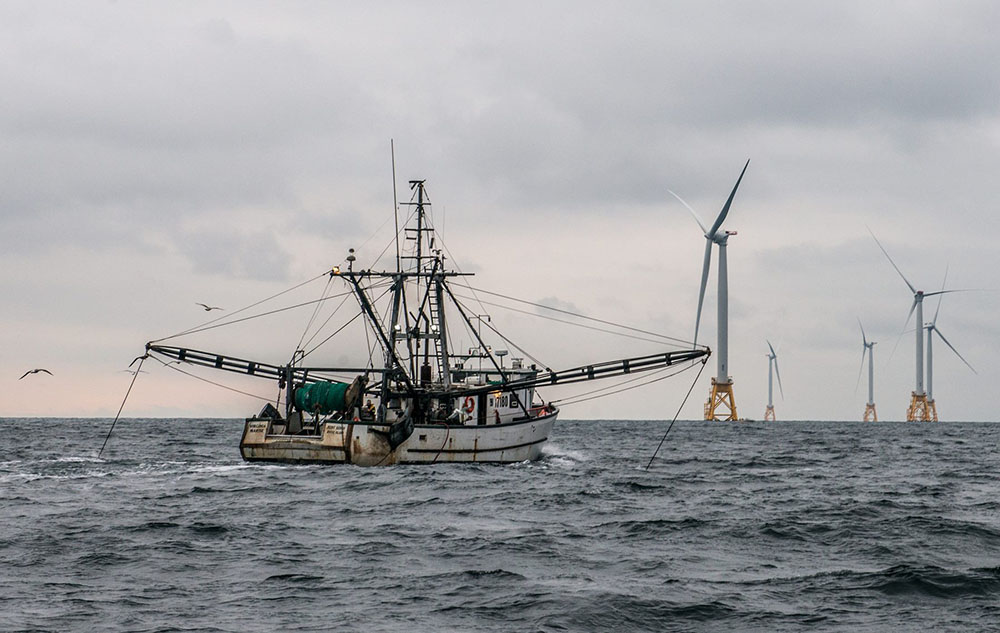Construction could begin on East Coast offshore wind energy projects in the next couple of years, but the state of science to monitor their environmental effects is lagging badly, experts said at the annual American Fisheries Society meeting.
“We’re talking about building projects in a few years…yet we lack a built, on-the-ground monitoring program,” said Andrew Lipsky, a planning officer who leads research into offshore wind energy with the NMFS Northeast Fisheries Science Center.
From Massachusetts to Maryland, state governments are aggressively promoting offshore wind power development, setting renewable energy goals, and striking deals for power purchase agreements.
The Northeast and Mid-Atlantic states are “where all the electrical demands are,” said Brian Hooker, a marine biologist with the federal Bureau of Ocean Energy’s renewable energy program. Those states are driving the demand and developers have a dozen approved federal leases, with BOEM now reviewing two construction and operation plans, Hooker said Tuesday at the AFS meeting in Atlantic City, N.J.
A daylong session featured presentations by researchers looking at how building arrays of wind turbines on the shallow continental shelf could affect fish populations, and the commercial fishing industry.
Fishermen share some of the same concerns as the maritime transportation sector, including safety of navigation, ensuring turbines are spaced widely enough to allow maneuvering and the issue of misleading radar echoes that can be generating by turbine rotors.
For mobile gear fishermen, there is fear that large parts of the leases could be effectively off-limits to them because towers are too close together to safely trawl of dredge. Advocates for the scallop and surf clam fleets argue that turbine arrays will effectively create “sanctuaries” for shellfish that are available in abundance thanks to responsible management.
This spring industry advocates organized the Responsible Offshore Development Alliance, to bring together diverse East Coast fishing fleets and operators to more effectively engage the wind industry and federal and state regulators.
Their goal is to “get better outcomes,” said Anne Hawkins of Kelley Drye & Warren LLP, a Washington, D.C., law firm that represents scallop fishermen who have sued in federal court over New York offshore wind proposals.
Maps prepared by BOEM using federal fisheries data shows existing wind leases and potential future lease areas overlapping with the scallop fishery, based out of ports like New Bedford, Mass., and Cape May, N.J.
“You can see how the proposed wind areas cover large parts of the scallop fishery,” Hawkins said at a panel discussion that capped the session. “We need to get back to basics and gather as much of this information as quickly as possible.”
Despite BOEM hosting listening sessions and other public events to get input about potential leasing areas, Hawkins said the fishing industry does not see transparency or consistency in how that information is being used. Fisheries considerations are not at all clear in the regulations governing wind development, she said.
“The problem we’re having with this (wind energy) development is we have this very dynamic fishery” off the East Coast, said Kevin Stokesbury, a professor at the University of Massachusetts Dartmouth School for Marine Science and Technology who has long worked with New England fishermen.
The industry includes a squid fleet that chases animals with 11-month lifespans and wildly varying movements, to dredging sea clams that grow in one place for decades. On top of the fluctuations in fish populations, climate change and slowly warming ocean water is shifting species farther north and east.
Fishermen expect the wind industry should be held to the same standard of science used for fisheries regulation, said Stokesbury.
“The problem that I see is we really haven’t made that decision,” he added. “In a few years, we’re going to have a lot of construction, and that doesn’t give us a lot of time to get the baseline down.”
Stokesbury recalled the scallop crisis of the late 1990s, when a dwindling resource and new fishing limits threatened to put fishermen on the ropes.
“The industry came to us and said, ‘Look, we need science to get us out of this hole,’” he said. Years of cooperative research between scientists, fishermen and agencies rebuilt the fishery, and grew it from $89 million a year in landings to $500 million annually, the richest on the East Coast.
Part of that solution was using some of the catch to pay for the science work, through research set-asides of quota.
“That structure seems to me to be a good example” of how research into wind energy might be financed, Stokesbury suggested. “You’re harvesting energy instead of food.”
“We’re ready to go,” but fishermen should not be paying for it, Hawkins responded: “This is a bigger issue than fisheries…there’s a lot of money coming into this from all sides.”
The wind developers are cautious about committing because it is unclear how much in all they will be asked to contribute, not just to fisheries research but to protecting endangered species and marine mammals, noted BOEM biologist Hooker.
Speakers agreed that it is unrealistic to expect new, dedicated government funding, and that existing efforts must be brought to bear on wind power planning. The engagement between developers and the Responsible Offshore Development Alliance is a start, and the Mid-Atlantic and New England Fishery Management councils should play a big role, they said.
“The infrastructure is there…we need to leverage these resources,” said Lipsky of NMFS. “This can’t be a bake sale approach. We have to think really big.”







